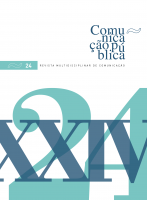Multimedia content and user preferences in online editorial projects
portuguese examples
DOI:
https://doi.org/10.4000/cp.2174Keywords:
Multimedia, online content, learning, website analysisAbstract
This study intends to be a contribution to the knowledge of Portuguese online thematic projects; editorial studies related to form and themes; and user preference studies. We aim to understand the selection of content in two online magazines – Azul - Ericeira Mag and Preguiça Magazine – and the user experience with these contents. A mixed approach was used, with the collection of information by e-mail with the collaborators of the two projects, the accomplishment of focus group with readers and analysis of the structure of the magazines. The conclusions highlight the amateurism in the selection of content themes by editors, as well as the prevalence of multimedia formats (text and image). Users, in turn, prefer diverse themes and formats, and clear and comprehensive categories that illustrate the themes of the content that can be found in the magazines.
Downloads
References
Cardoso, G., Magno, C., Soares, T. M., & Crespo, M. (orgs.) (2016). Modelos de Negócio e Comunicação Social. “Telcos”, Legacy Media, Novos Media e Start-ups Jornalísticas em Navegação Digital. Estudo Prospetivo (2015-2020). Coimbra: Almedina.
Corrêa, E. S. (2005). Comunicação digital: uma questão de estratégia e de relacionamento com públicos. Organicom, 2(3): 97-100. DOI : 10.11606/issn.2238-2593.organicom.2005.138900
Creswell, J. W. (2007). Understanding mixed methods research. In: Creswell, J. W. & Clark, V. L. P. (ed.). Designing and Conducting Mixed Methods Research. Thousand Oaks, CA: Sage: 1-19.
Criar uma Empresa (27 de outubro de 2016). AZUL – Ericeira Mag | NOS Empresas. [Internet] Disponível em: <https://www.youtube.com/watch?v=FQE5PtQP9sI&feature=player_embedded> [Consult. 31 de outubro de 2016].
Cunha, R. (2017). Design da Informação e Inovação em Produtos Jornalísticos para Tablets. Covilhã: Labcom, Universidade da Beira Interior.
Evans, L. (2014). 4 Ways To Retrain Your Brain To Handle Information Overload. Fast Company. [Internet] Disponível em: <https://www.fastcompany.com/3033845/4-ways-to-retrain-your-brain-to-handle-information-overload> [Consult. 11 de maio de 2017].
Garcia, G. M. (2007). Comportamento do Consumidor Virtual: a Influência das Características Pessoais na Intenção de Compra. Dissertação de Mestrado em Administração. Porto Alegre: Universidade Federal do Rio Grande do Sul.
Grupo Marktest (19 de setembro 2017). 5,9 milhões de utilizadores de Internet em Portugal. [Internet] Disponível em: <http://www.marktest.com/wap/a/n/id~22ba.aspx> [Consult. 3 de fevereiro de 2018].
Grupo Marktest (2 de novembro de 2016). Maioria dos portugueses recorre em primeiro lugar à internet quando necessita de uma informação. Marktest. [Internet] Disponível em: <http://www.marktest.com/wap/a/n/id~2158.aspx> [Consult. 27 de dezembro de 2016].
Grupo Marktest (28 de novembro 2017). 3,4 milhões em sites de informação em outubro. [Internet] Disponível em: <http://www.marktest.com/wap/a/n/id~2308.aspx> [Consult. 3 de fevereiro de 2018].
ISO 9241-210 Ergonomics of human-system interaction - Part 210: Human-centred design for interactive systems. [Internet] Disponível em: <https://www.iso.org/standard/52075.html>.
Keen, A. (2008). The Cult of the Amateur: How Blogs, MySpace, YouTube and the Rest of Today's User-generated Media are Killing our Culture and Economy. Londres/Boston: Nicholas Brealey Publishing.
Li, Z., Drew, M. S. e Liu J. (2004). Fundamentals of Multimedia (2ª ed.). Canadá: Springer. DOI : 10.1007/978-3-319-05290-8
Manovich, L. (2001). The Language of New Media. Cambridge/Londres: The MIT Press.
Mayer, R. E. (2001). Multimedia Learning. Nova Iorque: Cambridge University Press. DOI : 10.5926/arepj1962.41.0_27
Mayer, R. E. (2005). Cognitive Theory of Multimedia Learning. In: Mayer, R. E. (ed.). The Cambridge Handbook of Multimedia Learning. Nova Iorque: Cambridge University Press: 31-48.
McPheat, S. (2013). Content Marketing. Newbury: The Internet Academy.
McQuail, D. (2003). O desenvolvimento dos media de massas. In: McQuail, D. (ed.), Teoria da Comunicação de Massas. Lisboa: Fundação Calouste Gulbenkian: 17-35.
Mohler, J. L. (2001). Using Interactive Multimedia Technologies to Improve Student Understanding of Spatially-Dependent Engineering Concepts. West Lafayette: Purdue University.
Morais, J. (2011). O mix de comunicação das marcas de moda. Exedra: 121-123.
Morville, P. (2004). User Experience Design. Semantic Studios: [Internet] Disponível em <http://semanticstudios.com/user_experience_design/>.
Murphy, A. e Potts, J. (2003). Culture & Technology. Nova Iorque: Palgrave Macmillan. DOI : 10.1007/978-1-137-08938-0
Norman, D. (1988/2013). The Design of Everyday Things. Nova Iorque: Basic Books. DOI : 10.15358/9783800648108
Norman, D. A. (2005). Human-centered design considered harmful. Interactions, 12(4): 14-19. DOI : 10.1145/1070960.1070976
Paivio, A. (1971). Imagery and Verbal Processes. Nova Iorque: Holt, Rinehart, and Winston.
Paivio, A. (2006). Dual Coding Theory and Education. Michigan: University of Michigan School of Education.
Preguiça Magazine (s. d.). Estatuto Editorial. [Internet] Disponível em <http://preguicamagazine.com/estatuto-editorial/> [Consult. 31 de outubro de 2016].
Sebastião, S. P., Azevedo, C., Dias, D. e Santos, L. (2012). Faz o que te digo, mas não olhes para o que eu faço: as Consultoras de Relações Públicas e a Comunicação Digital, em Portugal. Observatorio (OBS*) Journal, 6 (1): 259-280.
SEG Research (2008). Understanding Multimedia Learning: Integrating multimedia in the K-12 classroom. Nova Iorque: BrainPOP.
Silva, A. S. & Pinto, J. M. (1999 [1986]). Metodologia das Ciências Sociais. 10ª ed. Porto: Edições Afrontamento.
Solomon, M. (2009). Os Segredos da Mente dos Consumidores. Famalicão: Centro Atlântico.
Sweller, J. (2003). Evolution of human cognitive architecture. In: Ross, B. (ed.). The psychology of Learning and Motivation: Advances in Research and Theory, vol. 43. Nova Iorque: Elsevier Science: 215-266. DOI : 10.1016/S0079-7421(03)01015-6
Web Content Accessibility Guidelines 2.0. [Internet] Disponível em <https://www.w3.org/TR/WCAG20/>.
Downloads
Published
Issue
Section
License
Copyright (c) 2018 Direitos do Autor (c) 2018

This work is licensed under a Creative Commons Attribution-NonCommercial 4.0 International License.
Os conteúdos da Comunicação Pública estão licenciados com uma licença Creative Commons - Atribuição-NãoComercial 4.0 Internacional.


